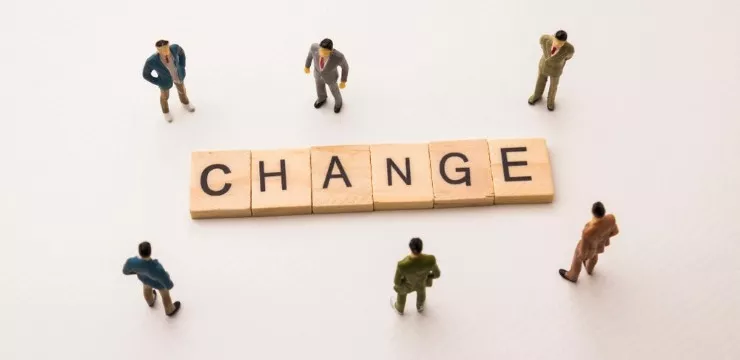
Change is the cornerstone of your organizational development 101, yet it isn’t always embraced with open arms.
In fact, employees commonly reject change through a fear of the unknown. But for your business to survive these difficult economic times, it must adapt to a modern business environment.
There are three constants in your day-to-day work… #change, choice and principles. #ChangeManagement
— Change Management (@Manage2change) January 27, 2018
This is very technologically driven, and companies are occasionally reluctant to transition because it requires a complete overhaul of processes and procedures.
This strikes fear in the hearts of organizations, who are concerned about taking a massive leap of faith. Without proper organization and planning, change initiatives can fail to reach desired consequences.
Fortunately change management models exist to guide organizations through an otherwise difficult process. But what exactly is a change management model? Let’s start with a quick definition:
What is a Change Management Model?
Change management models are useful because they simplify an otherwise complicated process.
They enable people to understand the stages of change, which are categorized according to the theory in question.
Change models are reliable because they are devised on the back of advanced research and experience. They appreciate the reality that change can never be executed perfectly, but explain how you can safeguard against potential issues.
When leveraging a change management model, what’s most important is you take a flexible approach. Tailor the model to your unique situation rather than following it too rigidly.
There is no right or wrong answer, knowing it’s your motivations that inspire strategy. Change implementation differs depending on the model you use, but there are basic steps which are widely applicable across the board.
One of the most easy to follow literatures is the Kurt Lewin change model. This is one of many advanced techniques you can master for organizational excellence
The model has become a staple of change theory, so let’s delve a bit deeper into what it entails:
Kurt Lewin Change Model
The Kurt Lewin change model uses the concept of water as an analogy, the perfect metaphor for change.
Water is subject to constant changeconstant change, existing in three forms depending on external environment.
The Kurt Lewin Change Model offers a practical understanding of the change process. Despite being produced in 1947, astonishingly it’s never been more relevant.
The model breaks down three main stages of change, which are as follows:
Unfreezing
Before attempting to change a process you must first break the constructs of the current status quo.
Staff will have grown accustomed to their way of doing things, so without unfreezing there will be a huge resistance to change.
This stage essentially involves encouraging staff to embrace change, which can be achieved by promoting the benefits of doing so.
Awareness must be created on how the current way of doing things is holding your organization back. Old practices should be examined to prove the necessity of change to staff.
Once staff begin to realize it’s evolve or become extinct, they’re more likely to align with a continuous development philosophy.
To lighten the mood in an otherwise dark time, you can always stimulate your team with marvelous game and activities. This is a great way to create dialogue and connect your team.
The most important element of the unfreezing stage is communication. Staff can be informed on change, while given an opportunity to offer valuable input.
The more staff know about the change, and understand how it’s essential to retain a competitive advantage, the more they’ll be incentivized to accept it.
Changing
Once your team has unfrozen they’ll be ready to transition into a new state of consciousness.
Their enhanced perception will create the perfect backdrop for moving on. Change can then be implemented effectively, but that doesn’t mean things will be plain sailing.
Staff might’ve accepted change, but how will they react to it in real time? Sometimes with uncertainty and fear, which can be difficult to overcome.
Your team will begin to learn new behaviors, ways of thinking, and processes. It’s important they’re not overwhelmed, and to allow staff time to adjust at their own pace.
Support your team with education and reassurance, while allowing them to vocalize their concerns. This will help staff grow familiar with the change in question.
It’s important to constantly remind staff of why the change is necessary, as motivation for their continued commitment.
Refreezing
Though Lewin actually referred to this stage as ‘Freezing’, it has been reconceptualized as ‘Refreezing’ because this symbolizes reinforcement.
Refreezing involves solidifying and stabilizing change, in the same way water does under the right conditions.
When change is accepted across the organization, it becomes an integral component of company culture.
This is confirmation that change has been successful, notified by it becoming the new status quo. It’s crucial people don’t revert back to their old ways, so vital change is reinforced until it’s second nature.
Change must be cemented and accepted as the new way of doing things. A great way to keep staff on track is by rewarding them for positive actions, specifically behaviors that align with change objectives.
Acknowledge good performance with positive reinforcement, and understand refreezing is less permanent than ever before.
That’s because we live in a rapidly advancing business world, where technology continually shifts consumer demands. Refreezing is important, but what’s important in modern business is you understand refreezing is subject to change.
WalkMe Team
WalkMe spearheaded the Digital Adoption Platform (DAP) for associations to use the maximum capacity of their advanced resources. Utilizing man-made consciousness, AI, and context-oriented direction, WalkMe adds a powerful UI layer to raise the computerized proficiency, everything being equal.



